Exploring topic modelling for generalising design requirements in complex design
IF 3.4
2区 工程技术
Q1 ENGINEERING, MULTIDISCIPLINARY
引用次数: 0
Abstract
AbstractAs the redesign process progresses in product lifecycle management, effectively managing engineering changes becomes increasingly challenging, often leading to catastrophic and costly project failures. In response, the study provides a framework for generalising design requirements documents into topics that engineers can use to understand complex designs. Based on previous work, this study employs and compares four different models, including latent Dirichlet allocation (LDA), the collapsed Gibbs sampling algorithm for the Dirichlet multinomial mixtures model (GSDMM), LDA-BERT, and GSDMM-BERT to determine the appropriate representation of requirements documents. Both heatmaps and UMAPs are used to illustrate the correlation between topics and words. The results indicate that the combined vector representation of topic modelling and the sentence-BERT model outperforms single topic modelling. This combined model leverages the additional knowledge from a pre-trained sentence-BERT model, thereby improving model performance and word distribution in all three industrial projects. Through this proposed framework, engineers can potentially generalise high-quality requirements topics for large requirements documents.KEYWORDS: Requirement managementrequirement topicscomplex designBERTdesign process Disclosure statementNo potential conflict of interest was reported by the author(s).Notes1 https://radimrehurek.com/gensim/models/ldamodel.html2 https://docs.scipy.org/doc/scipy/reference/generated/scipy.spatial.distance.pdist.html探索在复杂设计中概括设计需求的主题建模
摘要随着产品生命周期管理中重新设计过程的进展,有效地管理工程变更变得越来越具有挑战性,常常导致灾难性和昂贵的项目失败。作为回应,该研究提供了一个框架,将设计需求文档概括为工程师可以用来理解复杂设计的主题。在前人工作的基础上,本研究采用并比较了四种不同的模型,包括潜在狄利克雷分配(LDA)、狄利克雷多项混合模型(GSDMM)的崩溃吉布斯抽样算法、LDA- bert和GSDMM- bert,以确定需求文档的合适表示。热图和umap都用于说明主题和单词之间的相关性。结果表明,主题建模和句子- bert模型的组合向量表示优于单一主题建模。这个组合模型利用了来自预训练的句子- bert模型的额外知识,从而提高了所有三个工业项目中的模型性能和单词分布。通过这个建议的框架,工程师可以潜在地概括出大型需求文档的高质量需求主题。关键词:需求管理需求主题复杂设计bert设计过程披露声明作者未报告潜在利益冲突。注1 https://radimrehurek.com/gensim/models/ldamodel.html2 https://docs.scipy.org/doc/scipy/reference/generated/scipy.spatial.distance.pdist.html
本文章由计算机程序翻译,如有差异,请以英文原文为准。
求助全文
约1分钟内获得全文
求助全文
来源期刊

Journal of Engineering Design
工程技术-工程:综合
CiteScore
5.00
自引率
33.30%
发文量
18
审稿时长
4.5 months
期刊介绍:
The Journal of Engineering Design is a leading international publication that provides an essential forum for dialogue on important issues across all disciplines and aspects of the design of engineered products and systems. The Journal publishes pioneering, contemporary, best industrial practice as well as authoritative research, studies and review papers on the underlying principles of design, its management, practice, techniques and methodologies, rather than specific domain applications.
We welcome papers that examine the following topics:
Engineering design aesthetics, style and form-
Big data analytics in engineering design-
Collaborative design in engineering-
Engineering concept design-
Creativity and innovation in engineering-
Engineering design architectures-
Design costing in engineering
Design education and pedagogy in engineering-
Engineering design for X, e.g. manufacturability, assembly, environment, sustainability-
Engineering design management-
Design risk and uncertainty in engineering-
Engineering design theory and methodology-
Designing product platforms, modularity and reuse in engineering-
Emotive design, e.g. Kansei engineering-
Ergonomics, styling and the design process-
Evolutionary design activity in engineering (product improvement & refinement)-
Global and distributed engineering design-
Inclusive design and assistive engineering technology-
Engineering industrial design and total design-
Integrated engineering design development-
Knowledge and information management in engineering-
Engineering maintainability, sustainability, safety and standards-
Multi, inter and trans disciplinary engineering design-
New engineering product design and development-
Engineering product introduction process[...]
 求助内容:
求助内容: 应助结果提醒方式:
应助结果提醒方式:


